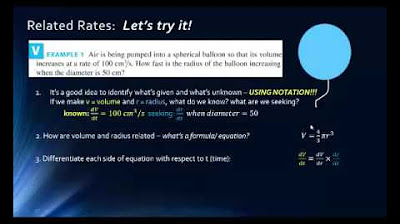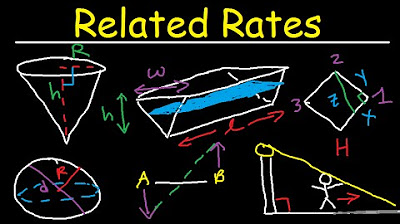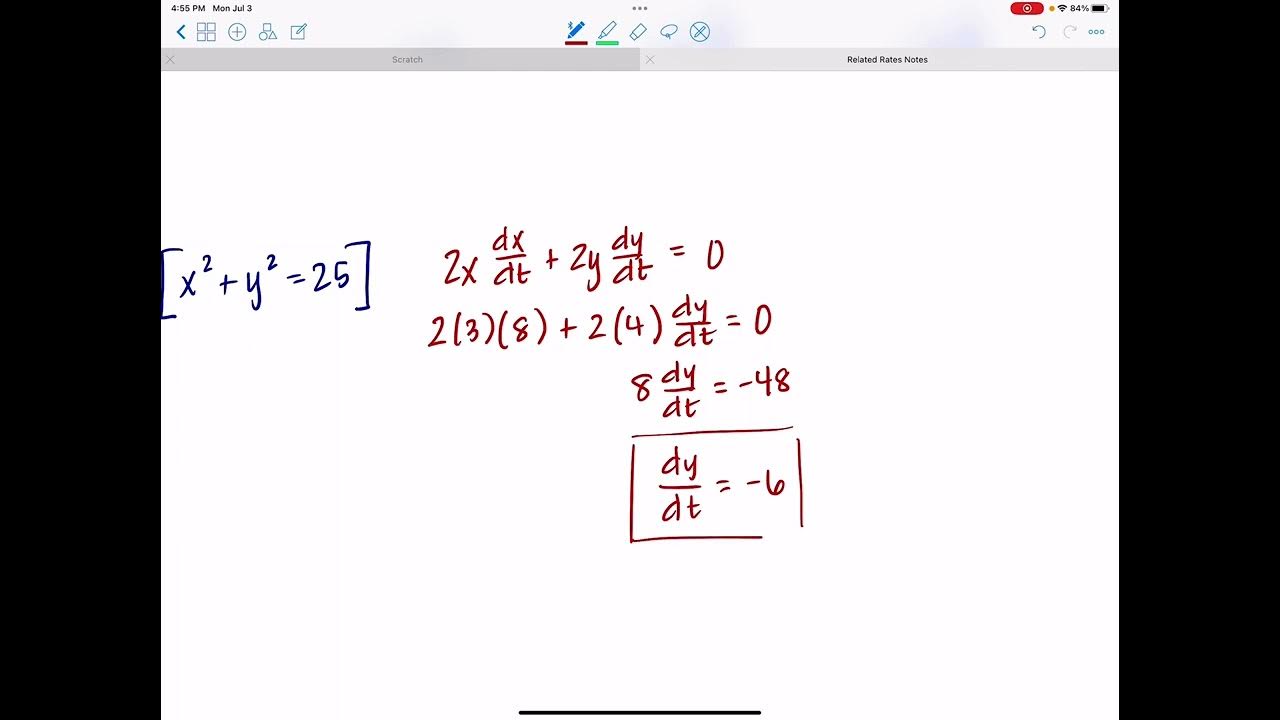Related Rates
TLDRThis video script delves into related rate problems in calculus, focusing on taking derivatives with respect to time. It guides through deriving expressions for various geometric formulas, such as the area of a circle and volume of a sphere, and solving for unknown rates using given information. The script includes examples like a balloon inflating and a ladder sliding down a wall, emphasizing the application of calculus in physics. It also covers translating word problems into calculus problems and solving them, providing a comprehensive understanding of the topic.
Takeaways
- 🔗 Related rates problems often involve taking derivatives with respect to time.
- 🔢 Implicit differentiation is useful for these problems, especially when dealing with multiple variables.
- ⏲️ Derivatives like dy/dt and dx/dt represent the rate of change of y and x with respect to time, respectively.
- 📐 Using the chain rule, we can find derivatives of expressions involving variables raised to powers, such as y^3 or x^2 + y^2.
- 🛠️ The product rule is essential when differentiating products of variables, such as x times y with respect to t.
- 🔄 Common geometry formulas, like the area of a circle (πr^2) or volume of a sphere (4/3πr^3), are frequently used in related rates problems.
- 🔢 Converting English statements into calculus expressions is a crucial step in solving related rates problems.
- 💨 Problems involving changing quantities, like a balloon being inflated or a square's side lengths shrinking, require calculating rates of change.
- 📏 For instance, the rate at which the perimeter of a square changes can be related to the rate of change of its side length.
- 📐 Applying these techniques, one can solve various problems, such as finding the rate of change in the area enclosed between a circle and a square or the rate of change of the area of a triangle.
Q & A
What is the derivative of y with respect to t?
-The derivative of y with respect to t is denoted as dy/dt.
How do you take the derivative of y to the third power with respect to t?
-The derivative of y^3 with respect to t is 3y^2 * dy/dt.
What is the derivative of x squared plus y squared with respect to time t?
-The derivative is 2x * dx/dt + 2y * dy/dt.
How do you take the derivative of x times y with respect to t using the product rule?
-You take the derivative of x*y with respect to t as follows: (x * dy/dt) + (y * dx/dt).
How do you solve for dy/dt given y = -2 and dx/dt = 2 in the equation x + 3y^2 = 8?
-Taking the derivative of both sides with respect to t, you get dx/dt + 6y * dy/dt = 0. Plugging in the values, 2 + 6(-2) * dy/dt = 0, which simplifies to dy/dt = 1/6.
What is the formula for the volume of a sphere, and how do you take its derivative with respect to time?
-The formula for the volume of a sphere is V = 4/3 * pi * r^3. The derivative with respect to time is dV/dt = 4 * pi * r^2 * dr/dt.
How is the rate of change of the radius of a balloon related to the volume of the balloon being inflated?
-If air is blown into the balloon at a rate of 2 cubic feet per second, you use the volume formula V = 4/3 * pi * r^3. Differentiating both sides with respect to t gives dV/dt = 4 * pi * r^2 * dr/dt, which allows you to solve for dr/dt.
How do you determine the rate of change of the area of a square when its side lengths are shrinking?
-Given the side length x, the area A = x^2. The derivative with respect to time is dA/dt = 2x * dx/dt. If dx/dt = -2 cm/s and the area is 49 cm^2, then x = 7 cm, so dA/dt = 2 * 7 * (-2) = -28 cm^2/s.
How do you find the rate at which the perimeter of a square is increasing if the circumference of an inscribed circle is increasing?
-If the circumference C of the circle is increasing at 6 inches per second, then C = 2 * pi * r, and dC/dt = 2 * pi * dr/dt = 6. Solving for dr/dt gives dr/dt = 3/pi. The perimeter P of the square is 8r, so dP/dt = 8 * dr/dt = 24/pi inches per second.
How do you find the rate of change of the area enclosed between a square and an inscribed circle?
-The area enclosed is the area of the square minus the area of the circle. The area of the square is (2r)^2 = 4r^2, and the area of the circle is pi * r^2. The rate of change of the enclosed area is dA/dt = 8r * dr/dt - 2 * pi * r * dr/dt. With dr/dt = 3/pi and r = 5, dA/dt = 8 * 5 * 3/pi - 2 * pi * 5 * 3/pi = 120/pi - 30.
Outlines
📚 Introduction to Related Rate Problems
This paragraph introduces the concept of related rate problems, focusing on the differentiation of various expressions with respect to time. The speaker begins by explaining the process of taking derivatives, starting with basic derivatives such as 'dy/dt' and moving on to more complex expressions involving powers and products. The paragraph sets the stage for solving related rate problems in physics, where equations are often given with all but one variable known, and the task is to find the missing rate of change. An example is provided where the derivative of an equation is taken to find 'dy/dt' when 'y' equals negative 2, given 'dx/dt' equals 2, resulting in 'dy/dt' equals negative 16.
🔍 Derivatives of Geometric Formulas
The speaker discusses the importance of understanding the derivatives of geometric formulas in solving related rate problems. Examples of the area of a circle and volume of a sphere are given, with the formulas 'pi * r^2' and '(4/3) * pi * r^3' respectively. The paragraph emphasizes the need to translate English sentences into calculus expressions, such as interpreting the rate of change of a circle's radius into the derivative 'dr/dt'. The speaker also touches on the topic of units in calculus, noting that while they are important, they typically take care of themselves in problems and are not the most challenging aspect.
🎈 Balloon Inflation and Related Rates
This paragraph presents a problem involving a balloon being inflated at a rate of two cubic feet per second. The speaker uses the volume formula for a sphere, '(4/3) * pi * r^3', to find the rate of change of the radius when the radius is three feet. By taking the derivative of the volume formula with respect to time and substituting the given values, the rate of change of the radius 'dr/dt' is calculated to be '2 / (36 * pi)', illustrating how to apply calculus to real-world problems.
📏 Shrinking Square and Area Change Rate
The speaker explores a problem where the side lengths of a square are shrinking at a rate of two centimeters per second. The focus is on finding how fast the area of the square is changing when the area is 49 square centimeters. By using the area formula for a square, 'x * x', and taking its derivative with respect to time, the rate of change of the area 'da/dt' is expressed in terms of 'dx/dt' and 'x'. Given 'dx/dt' is negative two and the area is 49, the side length 'x' is determined to be seven, leading to 'da/dt' being negative 28 square centimeters per second.
🔶 Circle and Square Tangency Problem
The paragraph discusses a problem where a circle is inscribed in a square, and both are expanding to maintain tangency. The circumference of the circle is increasing at a rate of six inches per second. The speaker uses the formulas for the circumference of a circle, '2 * pi * r', and the perimeter of the square, '8 * r', to find the rate at which the perimeter of the square is increasing. By taking the derivative of the circumference with respect to time and solving for 'dr/dt', the rate of change of the perimeter 'dp/dt' is calculated to be '24 / pi' inches per second.
🚀 Observer Watching a Rising Balloon
In this paragraph, the speaker describes a scenario where an observer is watching a balloon rising at a constant rate of three meters per second. The observer is 100 meters from a fixed point, and the task is to find the rate of change in the horizontal distance 'x' when the vertical distance 'y' is 50 meters. Using the Pythagorean theorem, the relationship between 'x', 'y', and the distance from the observer is established. By differentiating this relationship with respect to time and substituting the given values, the rate of change of 'x', 'dx/dt', is found to be '3 / sqrt(5)' meters per second.
📐 Triangle Area and Angle Rate of Change
The final paragraph presents a problem involving the rate of change in the area of a triangle and the angle it makes with the horizontal when observing a rising balloon. The area of the triangle is given by '1/2 * y * 100', and its derivative with respect to time is calculated to be '150' square meters per second. For part c, the speaker uses the tangent function to find the rate of change of the angle 'theta' with respect to time, 'dtheta/dt', by differentiating the tangent expression and substituting the known values, resulting in 'dtheta/dt' being '3 / (100 * cos^2(theta))' radians per second.
Mindmap
Keywords
💡Related Rate Problems
💡Derivative
💡Chain Rule
💡Implicit Differentiation
💡Product Rule
💡Geometry Formulas
💡Trigonometric Functions
💡Rate of Change
💡Units of Measure
💡Free Response Question
💡Tangency
💡Perimeter
💡Area
Highlights
Introduction to related rate problems and the use of chain rule in derivatives.
Derivative of y with respect to t is d/dt(y).
Derivative of y^3 with respect to t involves the power rule.
Derivative of x^2 + y^2 involves the sum rule and product rule.
Solving for dy/dt given dx/dt = 2 and y = -2.
Derivative of z^2 = x^2 + y^2 leads to a ladder sliding down a wall problem.
Calculation of dy/dt when y = -2 using the derivative of the given equation.
Derivative of area of a circle formula with respect to time.
Derivative of volume of a sphere formula with respect to time.
Translation of English sentences into calculus problems for related rate questions.
Example of a balloon inflation problem with air being blown in at a rate of 2 cubic feet per second.
Derivative of the volume formula for a sphere to find the rate of change of the radius.
Example of a square with shrinking side lengths at a rate of 2 centimeters per second.
Derivative of the area formula for a square to find the rate of change of the area.
Free response question from the 1994 calculus exam involving a circle inscribed in a square.
Derivative of the circumference formula to find the rate of change of the perimeter of the square.
Calculation of the rate of increase in the area enclosed between the square and the circle.
Example from the 1988 BC exam involving an observer watching a balloon rise.
Derivative of the distance formula to find the rate of change in x when y = 50.
Derivative of the area of a triangle to find the rate of change in the area at the instant when y = 50.
Use of tangent function to find the rate of change in theta when y = 50.
Transcripts
5.0 / 5 (0 votes)
Thanks for rating:





